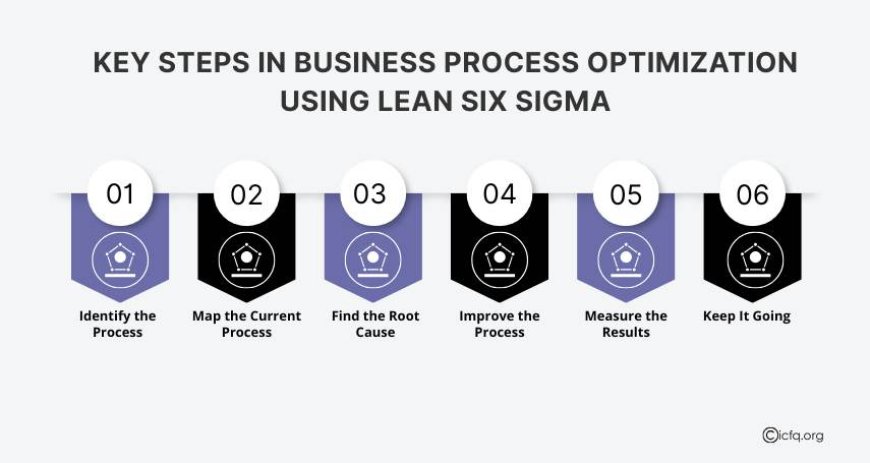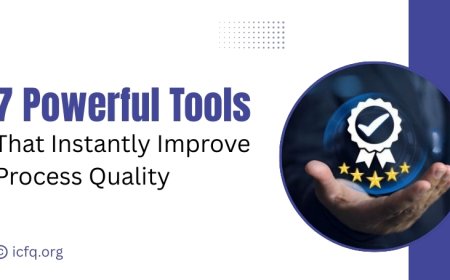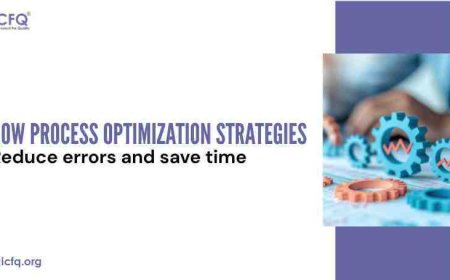What Is Business Process Optimization in Lean Six Sigma
Learn what Business Process Optimization in Lean Six Sigma means, how it improves workflow efficiency, reduces waste, and drives better business outcomes.

Have you ever felt like your business is working hard but not moving fast enough?
You meet deadlines, manage your team, and deliver results, but still, something feels stuck.
The reason might not be the people or the product.
It could be the process.
That’s where Business Process Optimization comes in.
And when you use it with Lean Six Sigma, it can completely change how your business works, making every step faster, smarter, and more efficient.
What Is Business Process Optimization?
Business Process Optimization (BPO) means improving how your business operates every day.
It’s about finding better ways to do things, saving time, reducing mistakes, and making sure every task adds real value.
Think of it like this:
If your business were a machine, process optimization is like oiling the gears so everything runs smoothly.
For example:
-
In a digital agency, client approvals may take too long. BPO helps speed that up.
-
In a factory, machines may stop too often. BPO helps reduce downtime.
-
In a hospital, patients might wait for hours. BPO helps improve the process flow.
The goal is simple: to make work faster, smoother, and more productive.
Why Businesses Need It
Every business has hidden gaps, slow approvals, repeated errors, or unnecessary steps.
These small issues add up over time, wasting hours, money, and effort.
With optimization, you can:
-
Save time and cost
-
Deliver better quality
-
Make employees more productive
-
Increase customer satisfaction
It’s not about working harder, it’s about working smarter.
Understanding Lean Six Sigma
It’s a method used by successful companies around the world to make their operations more efficient and consistent.
It combines two strong ideas:
-
Lean: Removes waste, anything that doesn’t add value to the customer.
-
Six Sigma: Reduces errors by improving quality and consistency.
Together, Lean Six Sigma helps businesses deliver better results in less time with fewer mistakes.
How Lean Six Sigma and Process Optimization Work Together
When you apply Lean Six Sigma to Business Process Optimization, you don’t just make random changes, you improve based on facts and results.
Here’s how this combination works:
-
You find what’s slowing you down.
-
You study the root cause of the problem.
-
You remove waste and make the process simpler.
-
You track results and keep improving.
This way, every small improvement creates a long-term impact on the entire business.
Key Steps in Business Process Optimization Using Lean Six Sigma

Step 1: Identify the Process
First, pick one process that causes the most trouble.
It could be late deliveries, repeated client complaints, or slow communication between teams.
For example, in a marketing agency, the delay in content approval may stop campaigns from going live on time.
That’s a process that needs improvement.
Step 2: Map the Current Process
Create a simple visual of how the process works now, every step, every approval, every delay.
This shows where time and effort are being wasted.
When you see it on paper, problems become clear.
Step 3: Find the Root Cause
Use a “why” analysis — ask why each problem is happening until you reach the real cause.
Example:
-
Why are client approvals late?
→ Because feedback comes from too many people.
-
Why from too many people?
→ Because there is no clear approval rule.
That’s the root cause
Step 4: Improve the Process
Now, remove what’s not needed.
You can reduce steps, automate tasks, or assign one person as the final approver.
The aim is to make the process simpler and faster.
In Lean Six Sigma, this stage is known as “Improve.”
Step 5: Measure the Results
Once changes are made, track results.
Did it save time?
Did it reduce errors?
Did the customer notice better service?
Lean Six Sigma believes in data-driven improvements , meaning every change should show clear results.
Step 6: Keep It Going
After improving a process, don’t stop.
Continue to monitor it regularly so it doesn’t fall back into old habits.
This step is called Control in Six Sigma.
Continuous monitoring ensures your business stays efficient all the time.
Benefits of Business Process Optimization with Lean Six Sigma
When you apply Lean Six Sigma to process optimization, you can expect real, measurable benefits:
-
Better Quality: Fewer mistakes and more consistent results.
-
Faster Workflows: Shorter timelines and smoother communication.
-
Cost Reduction: Less waste means lower costs.
-
Higher Customer Satisfaction: Customers get better service and faster delivery.
-
Stronger Teams: Employees become more confident and efficient.
-
Continuous Growth: Businesses keep improving year after year.
These benefits don’t come overnight - but they last long-term.
Why It Matters for Modern Businesses
Today’s world is changing fast.
Customers expect quick, high-quality results.
If a business takes too long or makes too many errors, people move to competitors.
That’s why companies now focus on process optimization - to stay ahead in speed, quality, and trust.
By combining it with Lean Six Sigma, businesses create a culture of continuous improvement.
It helps them adapt to change, save resources, and deliver better outcomes every time.
How Small Businesses Can Use Lean Six Sigma
Many people think Lean Six Sigma is only for big companies. That’s not true.
Even small businesses can use its methods to grow faster.
Here’s how:
-
Start by finding one process that slows you down.
-
Use a simple checklist to find where the problem starts.
-
Remove unnecessary steps or duplicate work.
-
Set a rule for approvals or automation.
-
Review results every month.
These small actions create big differences over time.
You don’t need expensive tools - you just need a clear process and consistency.
Common Mistakes to Avoid
When businesses start optimizing processes, they often make these mistakes:
-
Trying to fix everything at once.
Start small. Focus on one problem at a time.
-
Ignoring employee feedback.
The people who use the process daily often know it best.
-
Skipping measurement.
Without data, you can’t see what’s improving.
-
Not maintaining the change.
Continuous improvement is the key - not one-time changes.
Avoiding these mistakes ensures long-lasting results.
The Future of Business Process Optimization
Technology is making optimization easier than ever.
Automation tools, data dashboards, and digital workflow systems help track performance and spot problems early.
But remember - technology is only helpful when processes are strong.
That’s why Lean Six Sigma remains the base for improvement.
It ensures every tool is used in the right way, for the right purpose.
The future belongs to businesses that keep improving every day, no matter how small the step.
Business Process Optimization in Lean Six Sigma is all about making work better, faster, cleaner, and more effective.
It helps businesses reduce waste, improve quality, and give customers a smoother experience.
Whether you run a startup, a small company, or a global brand, these methods help you grow by improving how your team works every single day.
In the end, success isn’t about doing more - it’s about doing better.
And that’s exactly what Lean Six Sigma teaches.




























